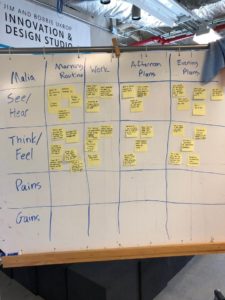Developing personas for our project has been a creative and beneficial exercise towards applying everything we have done up to this point. However, I will say it has not been the smoothest of transitions. First, discovering the personalities of our personas was a somewhat slow moving process because we wanted to accurately capture two of the different areas the target market of our scope described. I feel like we were trying to describe people from our interviews and observations, thinking they were the exact mold we were trying to reach. Instead they represent the broader scale of that segment. While it is good to have related information from the interviews and observations to use for the the personas, they did not have to be completely affiliated with one another. But with some individual work after the in class brainstorming, we were able to sort out both personas. This was helpful because it pointed out what kind of details were similar and different between the two, giving us a better idea what things would be constants moving forward and what things we would have to appeal to based on each individual person. The primary differences we noticed were Type of Employment (specifically hours), Certain Individual Personality Characteristics, and Relationship Status and how this effects them having roommates or not.
Next, we started working on the mapping for one of our personas. We used persona one and named her Malia. During our in class time to sort this out, we quickly identified that the Journey Map is the mapping we needed to use. We discussed what exactly we wanted to map since we have a two faceted approach. We decided to take a look at her Friday schedule since that could offer insight to both her work day and weekend plans. As Process Champion for the day, I did not do the best keeping us on the right track. I say that because starting this portion of the project, housing, to me, was the clear area we needed to focus on. However, after discussing it with my teammates, they brought up our other area of focus specifically for the project, which was community. From there I should have made sure both were being represented before and during the brainstorming of the different categories. After that time, we looked back at what we all had put and realized very little of it actually had anything to do with housing. Obviously this was a concern because that is the root of the project.

We gathered the next day to discuss and finish up the Journey Map. After talking with my teammates, I feel like we learned very insightful information into not just the continued focusing of our scope, but also that both the community and housing factors need to be addressed together instead of independently.
Lastly, we moved onto identifying the pains and gains of the mapping. Since refocusing our direction of Malia’s daily experiences, we were able to identify these pretty quickly for her morning routines and evening plans. Her afternoon plans took some more brainstorming, but it was her work time that ultimately required the most attention to figuring out. We kept it as part of the mapping because it fits with our community side of the scope. But keeping housing in mind, it was difficult finding the pains and gains for it since it appeared so unrelated to that part alone.
Overall I would say during the actual activities for this stage of the project, I did not really understand how certain things we were working on would actually help us, even after doing the reading. However, after I feel like we learned some very valuable information that will definitely help our focus moving forward.